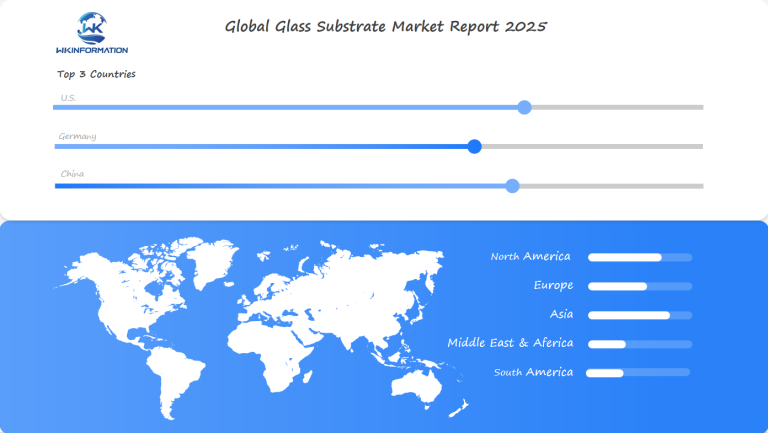$8.43 Billion Glass Substrate Market Set for Rapid Growth in the U.S., Germany, and China by 2025
Explore the expanding Glass Substrate Market driven by increasing demand in electronics, displays, and automotive sectors. Key growth regions include the U.S., Germany, and China through 2025.
- Last Updated:
Projected Market Insights for Glass Substrate in Q1 and Q2 of 2025
The Glass Substrate market is expected to reach $8.43 billion in 2025, with a CAGR of 6.5% from 2025 to 2033. In Q1, the market is projected to generate around $2 billion, driven by increasing demand for glass substrates in the electronics, automotive, and solar energy industries. By Q2, the market is expected to grow to about $2.1 billion, reflecting continued demand.
The U.S., Germany, and China are expected to lead in this market, with the U.S. at the forefront of electronics and semiconductor industries, Germany contributing significantly through its automotive sector, and China driving the manufacturing of displays and solar panels. The continuous advancements in display technologies, coupled with the push for renewable energy, will further fuel growth in these key regions.

Understanding the Upstream and Downstream Industry Chains
The glass substrate supply chain is a complex network of industries. It drives innovation and market growth. This ecosystem spans many industry verticals, creating a dynamic production and consumption landscape.
Raw material suppliers play a crucial role in the glass substrate market. They are dedicated to producing high-performance materials that comply with stringent technological requirements.
Key Components of the Supply Chain
Upstream Components
- Upstream suppliers providing specialized raw materials
- Manufacturing facilities producing glass substrates
- End-user industries consuming glass substrate technologies
Downstream Applications
Downstream applications show the versatility of glass substrates. The market includes:
- Consumer electronics
- Power vehicles
- Electric power storage
- Industrial applications
The average annual growth rate of strategic emerging industries is maintained at over 20%, highlighting the significant potential within glass substrate technologies.
Improving flat panel display glass is a focus for new material industries. Efforts to improve localization and develop core production technologies are driving market expansion and innovation.
Key Players in the Market
Leading companies such as Asahi Kasei, Toray, and SK Innovation are at the forefront of glass substrate development. Their research and production efforts have a significant impact on the global market.
Key Trends Driving the Glass Substrate Market
The glass substrate market is growing fast. This is thanks to new tech and more people wanting gadgets. New display tech is changing the game, opening doors for makers and scientists.
- Increasing smartphone and tablet production
- Advanced display technology requirements
- Rising demand for high-resolution screens
- Emergence of flexible electronic devices
Technological Breakthroughs in Consumer Electronics
Consumer electronics are driving significant changes in the glass substrate market. Manufacturers are developing improved substrate materials to accommodate new device designs. The demand for thinner, lighter, and stronger gadgets is fueling a substantial requirement for specialized glass.
The industry is witnessing significant advancements in glass substrate technology. Companies are investing heavily in research to develop substrates for modern devices.
| Market Segment | Growth Projection |
| Smartphone Displays | 12.5% Annual Growth |
| Tablet Screens | 8.3% Annual Growth |
| Wearable Technology | 15.7% Annual Growth |
These trends highlight the growing significance of glass substrates in shaping the future of consumer electronics. As technology continues to evolve, the demand for high-quality glass substrates will only intensify.
Overcoming Challenges in the Glass Substrate Market
The glass substrate industry faces complex challenges. It needs new solutions. Companies are working on ways to be environmentally friendly while keeping costs low.
Dealing with these challenges requires a broad approach. Companies are using new methods to reduce environmental harm and improve production.
Strategic Sustainability Efforts
Sustainability is key in the glass substrate market. Manufacturers are focusing on several important strategies:
- Reducing energy use during making
- Starting recycling programs for glass
- Creating low-carbon making technologies
- Looking for new raw material sources
“Our goal is to make high-performance glass substrates with less environmental harm,” says a leading industry expert.
The need for greener production is pushing for new tech. Companies are putting money into research. They want to make glass substrates that are both high-quality and eco-friendly.
Cost Management and Production Efficiency
To tackle manufacturing challenges, companies are using advanced techniques:
- Starting automated production systems, which include various manufacturing automation applications
- Using predictive maintenance tech
- Streamlining manufacturing processes
- Investing in precise engineering
The glass substrate market keeps growing. Sustainability and cost-effectiveness are driving new strategies in the industry.

How Geopolitics Are Shaping Glass Substrate Demand
The global glass substrate market is changing fast because of complex global politics. Trade policies are making things more complicated, offering both challenges and chances for companies worldwide.
Politics are changing where glass substrates are made and sold. Important factors include:
- Shifting trade rules between big countries
- Regional tech skills
- Strategic economic partnerships
- Keeping supply chains strong
Regional Market Transformation Strategies
North America is currently the leader in the glass substrate market. It has strong technology and good trade connections. The United States plays a key role in creating advanced facilities for developing new substrate technology.
Asia-Pacific is experiencing rapid growth, with China and South Korea at the forefront. They are heavily investing in research and production of glass substrates. Their goal is to enhance their trade capabilities and technological expertise.
The trade landscape for glass substrates is constantly evolving. Companies are adapting by diversifying their supply chains and establishing local production facilities.
Market Segmentation and the Leading Types of Glass Substrates
The glass substrate market is a complex world of advanced materials. It’s vital for many high-tech industries. Knowing about market segmentation helps us understand the different types of substrates and their uses.
Different types of glass substrates are key to technology’s success in various fields. The market is divided into several main categories. Each has its own special features and uses.
Primary Glass Substrate Classifications
- Borosilicate-based substrates
- Fused silica and quartz-based substrates
- Silicon-based substrates
- Specialized composite materials
Market segmentation gives us important insights into the world of substrates. Silicon-based substrates are the biggest players globally. They are used in many technological areas.
| Substrate Type | Primary Applications | Market Share (%) |
| Silicon-Based | Electronics, Semiconductors | 45% |
| Borosilicate | Laboratory Equipment, Optics | 25% |
| Fused Silica | Photonics, Aerospace | 20% |
| Other Composites | Specialized Technologies | 10% |
“The future of glass substrate technologies lies in understanding their nuanced market segmentation and potential for innovation.” – Advanced Materials Research Institute
Regional trends also influence the glass substrate market. North America is at the forefront. It’s driven by big research investments and advanced technology.
Applications Powering the Growth of Glass Substrates
Glass substrates are changing many industries, leading to new tech and energy breakthroughs. They are key in both new and old ways of making things.
- Electronics Manufacturing: Essential for LCD and OLED displays
- Solar Power Generation: Boosts photovoltaic cell efficiency
- Semiconductor Development: Crucial for advanced microelectronic circuits
- Automotive Technologies: Enables advanced display and sensor systems
Electronics and Display Technologies
Glass substrates have transformed the production of electronic devices. The semiconductor industry relies on them for their unique characteristics. Corning’s Gorilla Glass Ceramic represents a significant advancement, enhancing the durability of devices even after accidental drops.
Renewable Energy Innovations
Solar energy is growing fast, with glass substrates key in making solar cells better. The market is expected to grow by 18.9% from 2022 to 2031, thanks to more solar installations.
Emerging Technology Frontiers
New uses include wearable tech, flexible displays, and medical advancements. Companies like Samsung are using advanced glass substrate tech. This shows how glass can make devices stronger and better.
Global Glass Substrate Market Trends
The global glass substrate market is changing fast. This change comes from new technologies and growing electronic industries around the world. Looking at the current scene shows big trends in different regions that are changing the market’s future.
Regional Market Performance Insights
Each region has its own special traits in glass substrate development:
- North America is a leader in new tech
- Asia-Pacific is growing fast in manufacturing
- European markets are all about precision engineering
| Region | Market Share | Growth Projection |
| North America | 35% | 7.2% CAGR |
| Asia-Pacific | 40% | 8.5% CAGR |
| Europe | 25% | 5.9% CAGR |
“The glass substrate market represents a critical technological frontier with immense growth potential across global markets.” – Industry Research Report
Investments in research and development are key. They help move glass substrate technologies forward. This puts them at the center of new electronic and manufacturing breakthroughs.

Growth Drivers in the U.S. Glass Substrate Market
The U.S. glass substrate market is growing fast. This growth comes from new technologies and strong demand from industries. The United States is a leader in North America, always finding new ways to improve materials and manufacturing.
Several factors are pushing the U.S. market forward:
- New technologies in fields like electronics, solar power, and advanced manufacturing.
- Strong demand from industries using glass substrates.
- Continuous innovation in material science and production techniques.
These areas are key to moving the glass substrate market ahead.
Technological Innovation Powering Market Expansion
The growth of the glass substrates market is being fueled by various technological innovations, including:
- Advanced semiconductor manufacturing needing precise glass substrates
- New uses in renewable energy technologies
- More need for special electronic parts
Leading companies in the U.S. are driving innovation. They invest in research and new technologies. Arcmatic Welding and Phoenix International are leading the way in glass substrate advancements.
Industrial Demand and Market Potential
The U.S. market has a lot of room to grow. New technologies are opening doors in many industries. Manufacturers are working on making glass materials better and more efficient for these new needs.
China’s Influence in the Glass Substrate Market
The Chinese glass substrate industry is now a major force worldwide. It’s changing the game in Asia. China is leading the way with fast tech growth and smart manufacturing.
China’s glass substrate production is booming. This growth is thanks to several key factors:
- Strong electronics manufacturing in China
- Big investments in research and development
- Lower production costs
- Top-notch tech infrastructure
Manufacturing Expertise and Worldwide Influence
Chinese manufacturers have become top competitors in the world. They focus on:
- Improving production speed
- Using the latest manufacturing methods
- Creating precise substrate technology
China’s influence goes beyond manufacturing. They set global prices and technology standards. Experts say China will continue to grow in the global glass substrate market. This is due to their emphasis on new technology and large-scale production.
Germany’s Role in the Glass Substrate Industry
The European glass substrate market has grown a lot. Germany has become a key player in this growth. It’s known for its innovation in glass substrate development.
Germany’s success in the glass substrate industry can be attributed to several factors:
- Precision engineering capabilities
- Advanced research and development infrastructure
- Strong manufacturing ecosystem
- Commitment to technological excellence
Technological Leadership in European Markets
German manufacturers lead in glass substrate production. They are experts in many fields, like electronics, semiconductors, and renewable energy.
| Industry Sector | German Market Contribution | Innovation Impact |
| Electronics | 42% of European production | High-precision substrate development |
| Semiconductor | 35% market share | Advanced material composition |
| Renewable Energy | 25% technological leadership | Sustainable substrate solutions |
Germany’s strong research and industry partnerships help the European market. German companies work hard to create new substrate technologies. They aim to solve global challenges.
German engineering is known worldwide for its excellence in glass substrate innovation and precise manufacturing.
As the world needs more advanced materials, Germany is key. It shapes the future of glass substrate technologies in many high-tech fields.
Future Innovations and Opportunities in Glass Substrates
New technologies are making glass substrates do more. Companies like Schott are making super thin and flexible glass. This glass could change many industries.
Cutting-Edge Material Developments
The future of glass substrate innovations focuses on a few key areas:
- Ultra-thin glass for wearable electronics
- Biocompatible substrates for medical devices
- High-performance materials for advanced optical systems
- Flexible substrates for renewable energy technologies
Emerging Market Opportunities
There are big chances in areas like:
- Advanced medical device manufacturing
- Next-generation display technologies
- Internet of Things (IoT) devices
- Sustainable energy solutions
As research goes on, glass substrate tech will get even better. It will help in electronics, medicine, and green energy.
Who’s Leading the Glass Substrate Market
The glass substrate market is highly competitive, with several key players at the forefront, driving innovation with new technologies.
- AGC Inc. – Japan
- Schott – Germany
- Corning Incorporated – USA
- Nippon Sheet Glass Co. – Japan
- Plan Optik AG – Germany
- HOYA Corporation – Japan
- Ohara Inc. – Japan
- IRICO Group New Energy Company Limited – China
- Toppan Inc. – Japan
- Tunghsu Group Co. Ltd. – China
Overall
| Report Metric | Details |
|---|---|
| Report Name | Global Glass Substrate Market Report |
| Base Year | 2024 |
| Segment by Type |
· Silicon-Based · Borosilicate · Fused Silica · Other Composites |
| Segment by Application |
· Electronics · Solar Power · Semiconductor · Automotive |
| Geographies Covered |
· North America (United States, Canada) · Europe (Germany, France, UK, Italy, Russia) · Asia-Pacific (China, Japan, South Korea, Taiwan) · Southeast Asia (India) · Latin America (Mexico, Brazil) |
| Forecast units | USD million in value |
| Report coverage | Revenue and volume forecast, company share, competitive landscape, growth factors and trends |
The glass substrate market continues to evolve as a cornerstone of technological progress. Key trends, such as advancements in thin-film technologies and the rise of sustainability initiatives, are reshaping its trajectory. Industries like electronics, automotive, and renewable energy drive demand, highlighting the market’s vast potential for innovation and growth. Companies like Corning Incorporated and AGC Inc. lead with cutting-edge solutions, ensuring the sector remains competitive. Sustainability and precision manufacturing will play pivotal roles in future developments, aligning with global priorities and fostering long-term growth in glass substrate revenue.
Global Glass Substrate Market Report (Can Read by Free sample) – Table of Contents
Chapter 1: Glass Substrate Market Analysis Overview
- Competitive Forces Analysis (Porter’s Five Forces)
- Strategic Growth Assessment (Ansoff Matrix)
- Industry Value Chain Insights
- Regional Trends and Key Market Drivers
- Vacuum Arc RemeltingMarket Segmentation Overview
Chapter 2: Competitive Landscape
- Global Glass Substrateplayers and Regional Insights
- Key Players and Market Share Analysis
- Sales Trends of Leading Companies
- Year-on-Year Performance Insights
- Competitive Strategies and Market Positioning
- Key Differentiators and Strategic Moves
Chapter 3: Glass Substrate Market Segmentation Analysis
- Key Data and Visual Insights
- Trends, Growth Rates, and Drivers
- Segment Dynamics and Insights
- Detailed Market Analysis by Segment
Chapter 4: Regional Market Performance
- Consumer Trends by Region
- Historical Data and Growth Forecasts
- Regional Growth Factors
- Economic, Demographic, and Technological Impacts
- Challenges and Opportunities in Key Regions
- Regional Trends and Market Shifts
- Key Cities and High-Demand Areas
Chapter 5: Glass Substrate Emerging and Untapped Markets
- Growth Potential in Secondary Regions
- Trends, Challenges, and Opportunities
Chapter 6: Product and Application Segmentation
- Product Types and Innovation Trends
- Application-Based Market Insights
Chapter 7: Glass Substrate Consumer Insights
- Demographics and Buying Behaviors
- Target Audience Profiles
Chapter 8: Key Findings and Recommendations
- Summary ofGlass Substrate Market Insights
- Actionable Recommendations for Stakeholders

Access the study in MULTIPLEFORMATS
Didn’t find what you’re looking for?
TALK TO OUR ANALYST TEAM
Need something within your budget?
NO WORRIES! WE GOT YOU COVERED!
Call us on: +1-866-739-3133
Email: infor@wkinformation.com
Which regions are leading the glass substrate market growth?
North America, Asia-Pacific, and Europe, especially Germany, are leading the market. Each region brings its own tech innovations and manufacturing skills.
What are the primary applications of glass substrates?
Glass substrates are key in many fields. They’re used in making electronics, solar panels, displays, and even in 5G networks.
How are environmental concerns impacting glass substrate production?
To reduce environmental impact, manufacturers are working on sustainable production. They aim to cut costs while keeping quality high and environmental effects low.
What technological trends are driving glass substrate market growth?
Trends driving growth include the need for more consumer electronics and better display tech. Also, there’s a push for ultra-thin, flexible glass and wearable tech innovations.
What types of glass substrates are most commonly used?
The market mainly uses borosilicate, fused silica, and silicon-based substrates. Each type has special properties for different tech uses.
How do geopolitical factors influence the glass substrate market?
Trade policies, international relations, and regional economies greatly affect the market. Countries like the U.S., China, and Germany are key in setting global trends.
What challenges does the glass substrate industry currently face?
The industry faces challenges like managing environmental impact, cutting costs, and keeping quality high. It also needs to keep up with fast-changing tech needs.
What role is China playing in the global glass substrate market?
China is becoming a big player in the market. It has strong manufacturing, a growing market, and is influencing global supply chains and prices.
What future innovations are expected in glass substrate technology?
Future innovations include ultra-thin, flexible glass, advanced materials for wearables, better optical uses, and new manufacturing methods.


